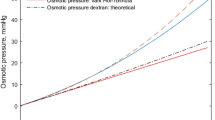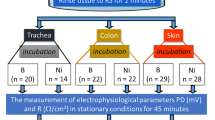Abstract
FROM experiments on the rat ileum in vitro Fisher1 and Smyth and Taylor2, using glucose-free media and metabolic inhibitors, suggested that the movement of water across the ileum was an active, metabolic dependent process. Parsons and Wingate3 observed that net movement of water took place agains4 an osmotic gradient, that is, with the mucosal solution hypertonic to tha serosal there was a net water movement from tne mucosal to the serosal surface. These workers again suggested that the process was an active one relatively independent of osmotic forces. Also, Smyth and Taylor4 using a glucose-free medium with isolated rat ileum found that the water movement was lowered in the absence of glucose and interpreted the process of water movement as being an active one. Hendley and Smyth5 have reported experiments showing that the concentration of sodium in the fluid appearing on the serosal surface is higher than the concentration on the mucosal surface of the rat intestine, indicating that there was active sodium transport, but have drawn no conclusions as to its primary role in solvent movement. Curran and Solomon6 and Curran7, on the other hand, have shown, both in vivo and in vitro, that the movement of water across the rat ileum is secondarily dependent on active transport of solute. Removal of the glucose from the medium results in a lowering of the solute transport and hence a fall in water movement. Similarly, using metabolic inhibitors the primary action of these was demonstrated to be on the salt transport mechanism and the water movement was shown to be only a secondary effect. Furthermore, the experiments of Curran7 show that, with isotonic conditions on both sides of the gut, a gradient of water activity is established as a result of the net solute transfer, and this is sufficient to explain the net solvent movement, thus affirming the passive nature of the water transfer.
This is a preview of subscription content, access via your institution
Access options
Subscribe to this journal
Receive 51 print issues and online access
$199.00 per year
only $3.90 per issue
Buy this article
- Purchase on SpringerLink
- Instant access to full article PDF
Prices may be subject to local taxes which are calculated during checkout
Similar content being viewed by others
References
Fisher, R. B., J. Physiol., 124, 21, P (1954).
Smyth, D. M., and Taylor, G. B., J. Physiol., 126, 42 P (1954).
Parsons, D. S., and Wingate, D. L., Biochim. Biophys. Acta, 30, 666 (1958).
Smyth, D. M., and Taylor, C. B., J. Physiol., 136, 632 (1957).
Hendley, E., and Smyth, D. M., J. Physiol., 139, 27, P (1957).
Curran, P. F., and Solomon, A. K., J. Gen. Physiol., 41, 143 (1957).
Curran, P. F., J. Gen. Physiol., 43, 1137 (1960).
Barry, B. A., Mathews, J., and Smyth, D. M., J. Physiol., 157, 279 (1961).
Crane, R. K., Biochim. Biophys. Acta, 45, 477 (1960).
Wilson, T. H., Amer. J. Physiol., 187, 244 (1956).
Rosenberg, T., in Active Transport and Secretion, Soc. Exp. Biol. Symp., 8, 27 (1954).
Ussing, H. H., in Ier Colloque de Biologie de Saclay, 139 (1958).
Wilson, T. H., and Wiseman, G., J. Physiol., 123, 116 (1954).
Parsons, D. S., Smyth, D. M., and Taylor, C. B., J. Physiol., 144, 387 (1958).
Hindle, W., and Code, C. F., Amer. J. Physiol., 203, 215 (1962).
Ussing, H. H., and Andersen, B., Proc. Third Intern. Biochem. Cong., 434 (1955).
Koefoed-Johnsen, V., and Ussing, H. H., Acta physiol. Scand., 28, 60 (1953).
Schoeffeniels, E., and Tercafs, R. R., Biochem. Pharmacol., 11, 769 (1962).
Author information
Authors and Affiliations
Rights and permissions
About this article
Cite this article
GREEN, K., SESHADRI, B. & MATTY, A. Independence of Transfer of Solute and Solvent across the Rat lleum. Nature 196, 1322–1323 (1962). https://doi.org/10.1038/1961322a0
Issue Date:
DOI: https://doi.org/10.1038/1961322a0
This article is cited by
Comments
By submitting a comment you agree to abide by our Terms and Community Guidelines. If you find something abusive or that does not comply with our terms or guidelines please flag it as inappropriate.



